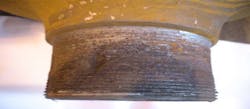Tube trailers and containers used to transport compressed gas under extremely high pressure are some of the most specialized pieces of equipment in the tank truck and container industries. Matt Sbrogna, IT director for FIBA Technologies, recently wrote about the importance of tube pinning in trailers and containers in an informative blog, which is reprinted with permission in this week’s issue of Bulk Logistics Trends.
Click here for the original post.
Tube pinning is a process FIBA Technologies uses to prevent tubes from rotating within their assemblies.
The majority of tubes used in tube trailers, ISO containers and ground storage assemblies are mounted in bulkheads. Tubes are held in the bulkheads by external threads machined onto the tube’s necks, which are then threaded into mounting flanges bolted to the bulkhead.
A typical tube, flange, bulkhead assembly:
Tubes without external neck threads mounted in a saddle configuration do not require tube pinning. Once the tube is installed into the bulkhead, a hole is drilled from the outside of the unit through the flange, and a small portion of the tube’s external threads. A pin is then inserted and welded into place, locking the tube orientation in place and preventing rotation.
Preventing tubes from rotating within their flanges is crucial to prevent wear and damage to the tube neck threads and the manifold. Pinning tubes to the flanges essentially marries the tubes and rear bulkhead, creating one solid structure. As the units are loaded onto trucks, travel over the road and positioned on site, there are strong torque and rotational forces on the unit. Without the tubes being pinned, these torque forces are transferred directly to the tubes’ external neck threads. The constant rubbing of the neck threads within the flange leads to worn tube threads.
Worn threads can lead to catastrophic consequences. The accident pictured below was the result of a collision involving a tube trailer that had tubes with worn threads. This accident led to the Compressed Gas Association publishing CGA C-23 Inspection of Tube Neck Mounting Surfaces, which is available on FIBA’s website.
By locking the tube threads to the flange and bulkhead, the torque forces on a unit are safely distributed along the entire length of the tube, minimizing the amount of wear on the tube threads.
For skids and trailers, the pinning procedure is performed on the rear of the unit. For Department of Transportation (DOT) and American Society of Mechanical Engineers (ASME) ground storage applications, the pinning operation is performed on the manifold end of the assembly. Although ground storage units are not subject to the same amount of movement as skids and trailers, it is still important to perform this procedure to protect the tubes from rotating during initial transportation and installation at the customer location.
The pin hole needs to be precisely drilled to a 90-degree angle to prevent removal of too much material from the tube and flange threads. A special temporary drilling jig is installed into the tube end to guide the drill bit to the correct location, depth and angle. Without the use of the jig, it’s very difficult to get the hole drilled correctly.
FIBA often receives tubes for requalification that have bad pin holes from equipment manufactured by other companies. If the pin hole does not penetrate the flange and tube threads perfectly, with the hole more on the flange side, the pin will not fully engage the tube and the tube will rotate, causing leaks and damage to the manifold. If the hole is drilled too deep into the threads and not enough into the flange, the minimum wall thickness of the tube neck may be too low for the pressure rating of the tube, and the tube will easily rotate causing leaks and manifold damage.
FIBA often re-qualifies tubes for customers on a five- or ten-year cycle. Part of the re-qualification is the inspection of the neck threads. The tubes below are examples of tubes not manufactured by FIBA. The first picture shows a tube that likely was drilled by hand, without the use of a jig. Too much thread material was removed and this tube needed to be removed from service per the specifications in CGA C-23 for not having enough remaining wall thickness.
As seen in the second picture, some tube manufacturers opt to use a set screw instead of a pin to try to prevent tube rotation. Set screws remove too much of the thread material and easily can be inserted too deep, reducing the minimum wall thickness of the tube to an unacceptable level.
FIBA’s procedure involves drilling two ¼” holes at the 3 o’clock and 9 o’clock positions on the tube. The depth of the hole will depend on the thickness of the flange and bulkhead. After both holes are drilled, the diameter, depth and perpendicularity are verified with gauges.
After these specifications are verified, metal chips and debris are removed and all surfaces are cleaned using an appropriate cleaning procedure dependent on the gas service. The pin can now be inserted into the hole with Loctite adhesive. With the pins in the holes, another set of perpendicular pins are laid flat on the face of the flange and welded in place to the flange and pin to prevent the anti-rotation pins from backing out. The unit now can be painted per customer specification.
















